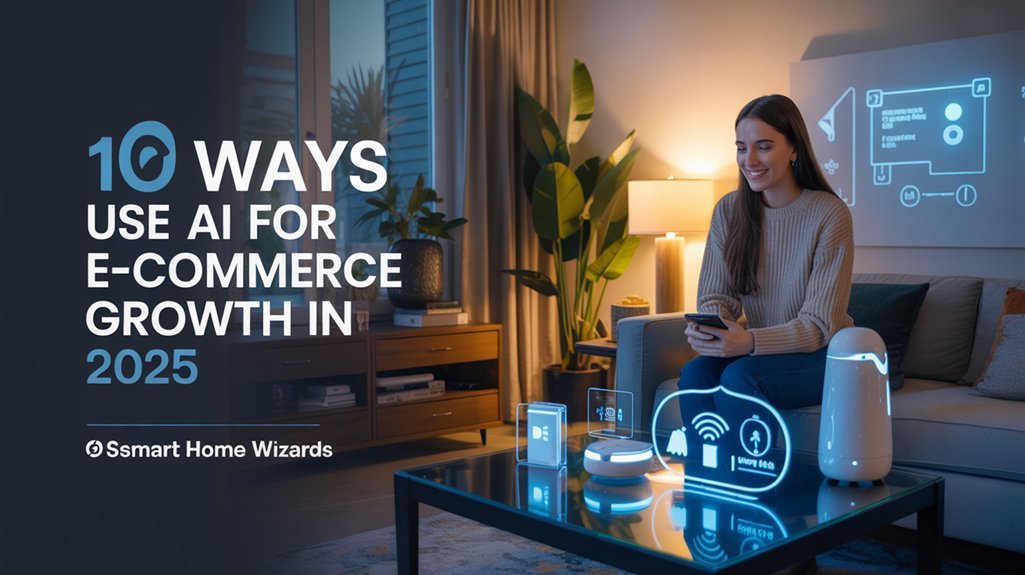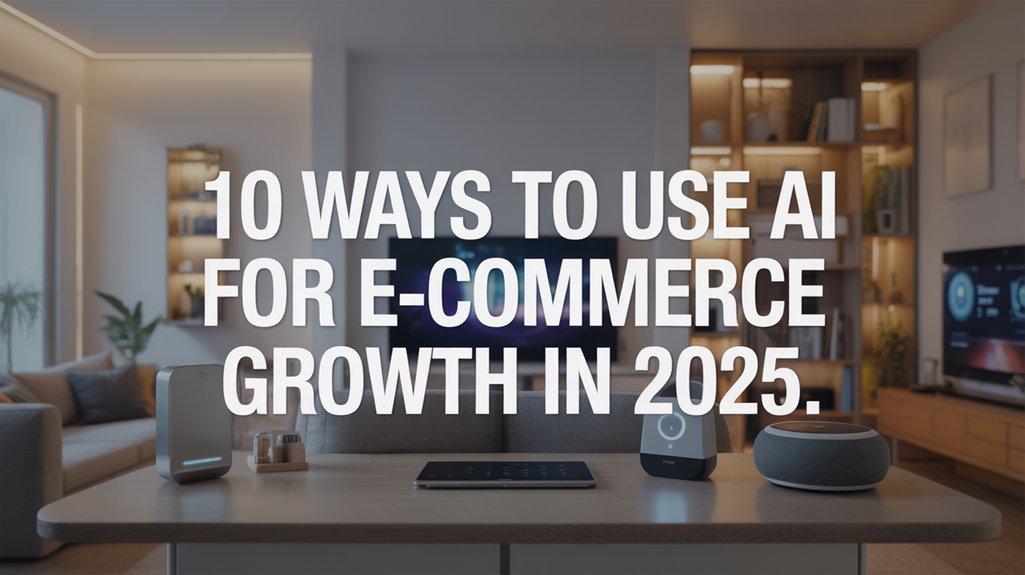
You'll accelerate e-commerce growth in 2025 by deploying AI chatbots that cut operational costs by 60% while handling 24/7 customer support, implementing personalized recommendations that boost conversions by 35%, and utilizing adaptive pricing algorithms for 25% revenue increases. AI-powered demand forecasting reduces stockouts by 75%, while intelligent segmentation improves retention by 30%. Agentic commerce systems autonomously enhance operations, and AI-generated content slashes creation time by 75% while enhancing SEO performance. The strategies below demonstrate exactly how to implement each capability for measurable returns.
Key Takeaways
- AI chatbots deliver 24/7 customer support, reducing operational costs by 60% while handling thousands of inquiries simultaneously and improving retention by 30%.
- Personalized AI recommendation systems increase conversion rates by 35% and customer retention by 30%, with 70% of consumers purchasing after tailored recommendations.
- Dynamic AI pricing algorithms boost revenue by 25% through real-time price adjustments based on competitor actions, demand patterns, and market conditions.
- AI demand forecasting reduces inventory errors by 50%, prevents stockouts by 75%, and decreases carrying costs by 20% through predictive analytics.
- Agentic AI autonomously optimizes operations across e-commerce platforms, enhancing conversion rates and reducing cost-per-acquisition through self-learning systems.
Personalized Product Recommendations That Drive Conversions
How can e-commerce businesses convert browsers into buyers more effectively?
Personalized product recommendations deliver measurable results: 35% higher conversion rates and 30% improved customer retention. AI-driven recommendation systems analyze consumer behavior, shopping history, and customer preferences to generate targeted suggestions that directly impact your bottom line.
AI-driven personalization transforms browsing behavior into revenue: 35% higher conversions, 30% better retention, measurable bottom-line impact.
The ROI speaks for itself. Seventy percent of consumers purchase when receiving personalized recommendations, translating to immediate revenue gains.
These systems excel at identifying cross-selling and upselling opportunities, increasing your average order value while simultaneously deepening customer relationships.
Your competitive advantage lies in deploying AI that understands individual preferences at scale. Nordstrom and leading retailers utilize these technologies not as optional improvements but as core revenue drivers.
The data is unambiguous: businesses implementing intelligent recommendation engines dominate their markets by changing casual browsers into loyal, high-value customers.
Maximizing this impact requires an AI SEO content optimizer to ensure your product pages and recommendations reach the right audience through search visibility.
Deploy AI-powered personalization now to capture market share and increase profitability in 2025's competitive landscape.
Dynamic Pricing Optimization for Maximum Revenue
You're leaving money on the table if you're still relying on fixed pricing strategies in today's volatile market.
AI-powered adaptive pricing enables you to adjust prices in real-time based on competitor movements, inventory levels, and customer demand patterns—delivering up to 25% revenue increases while maintaining ideal profit margins.
Real-Time Price Adjustments
Fluid pricing optimization represents one of the most powerful applications of AI in e-commerce, delivering measurable revenue gains through real-time price adjustments that respond to market signals within milliseconds.
You'll utilize AI tools to analyze real-time data streams—tracking competitor pricing, inventory levels, and consumer behavior—to execute pricing optimization strategies that optimize every transaction's value.
This approach drives revenue increases up to 25% while strengthening your competitive positioning against slower-moving rivals. By aligning prices with market trends and demand fluctuations instantly, you'll improve customer satisfaction through perceived value optimization.
Your flexible pricing system eliminates guesswork, replacing reactive strategies with predictive intelligence that captures profit opportunities before competitors recognize them, ultimately delivering documented revenue improvements of 15% or higher. Beyond pricing strategies, these same AI tools boost productivity across your entire e-commerce operation by automating data analysis and decision-making processes that would otherwise require extensive manual effort.
Competitive Market Positioning
While your competitors manually adjust prices every few hours or days, AI-driven fluid pricing algorithms continuously analyze thousands of market signals per second to position your products at revenue-maximizing price points. This competitive positioning advantage converts historical sales data into actionable intelligence, predicting customer demand patterns before market fluctuations impact profitability.
| Traditional Pricing | AI Price Optimization |
|---|---|
| Manual competitor checks | Real-time competitive analysis |
| Static discount schedules | responsive demand-based pricing |
| Gut-feel adjustments | Data-driven revenue growth |
| Generic customer pricing | Personalized value perception |
Your e-commerce operations gain immediate advantage through algorithms that balance margin protection with market capture. By leveraging AI insights to optimize your content strategy alongside pricing decisions, you create a comprehensive approach that resonates with customer behavior patterns. This strategic approach delivers 10-20% revenue growth while building customer loyalty through perceived fairness. You're not just competing—you're dominating through superior intelligence and execution speed.
Demand-Based Discount Strategies
AI-powered adaptable pricing alters static discount calendars into revenue-generating engines that respond to market conditions millisecond by millisecond.
Your flexible pricing system analyzes customer behavior patterns, competitive analysis data, and demand forecasting metrics to execute precision discount strategies that enhance revenue potential. You'll capture up to 25% more revenue by deploying AI algorithms that determine ideal markdown timing and depth based on real-time market signals.
This approach changes inventory management from reactive to predictive, eliminating costly stockouts while accelerating turnover rates.
Your pricing intelligence adapts instantly to demand fluctuations, ensuring profitability across every transaction. By leveraging machine learning for continuous competitive analysis, you'll maintain market dominance while extracting maximum value from each customer segment.
Strategic discount deployment becomes your weapon for sustainable growth. Developing an effective AI marketing strategy requires integrating these dynamic pricing capabilities with your broader revenue optimization goals to maximize competitive advantage.
AI-Powered Customer Service and Chatbots
Your customers expect instant responses, and AI-powered chatbots deliver round-the-clock support that cuts response times while slashing operational costs by up to 50%.
These automated systems handle repetitive inquiries and simple transactions without human intervention, allowing your team to focus resources on high-value, complex customer issues.
You'll see measurable ROI through reduced support expenses and increased customer retention rates—businesses report up to 30% improvement in retention through AI-enhanced engagement.
24/7 Automated Support Systems
Because customer expectations for immediate support continue to rise, automated support systems have become essential infrastructure for scaling e-commerce operations.
By automating customer support, you'll deliver instant responses that directly impact improved customer satisfaction while maintaining 24/7 availability. AI-powered customer service alters your support economics—achieving up to 30% reduction in customer service costs while simultaneously improving first-contact resolution rates.
Strategic advantages of implementing AI chatbots:
- Deploy instant responses across multiple channels without proportional cost increases
- Streamline operational efficiency by redirecting human agents to high-value interactions
- Utilize machine learning to create a personalized shopping experience that adapts continuously
- Scale support capacity during peak periods without hiring additional staff
- Generate actionable data insights from every customer interaction to refine conversion strategies
Your AI chatbots learn from each engagement, becoming increasingly effective at revenue protection and customer retention.
Reducing Response Time Costs
When customers wait more than 60 seconds for support responses, you're hemorrhaging revenue—and AI-powered chatbots eliminate this conversion killer by delivering instantaneous engagement that changes cost centers into profit drivers.
These automated systems slash operational costs by 60% while managing thousands of customer inquiries simultaneously, altering your customer service economics.
AI-driven systems analyze behavior patterns in real-time, delivering tailored responses that boost satisfaction rates by 25% and improve first-contact resolution by 50%.
You'll command 24/7 support coverage without proportional cost increases, positioning your brand as perpetually accessible.
Strategic implementation means reducing response times from minutes to milliseconds while reallocating human agents to high-value interactions that directly impact revenue.
This operational alteration converts reactive support into proactive profit generation.
Advanced Customer Segmentation and Targeting
While traditional demographic segmentation has served e-commerce businesses for decades, AI-powered customer segmentation alters how you identify and target your most valuable audiences.
Advanced customer segmentation analyzes vast datasets—purchase history, browsing behavior, and customer preferences—to create vibrant audience clusters that drive results.
AI-powered segmentation transforms raw customer data into actionable audience clusters that deliver measurable marketing performance and competitive advantage.
AI-driven segmentation delivers measurable competitive advantages:
- 30% improvement in customer retention through personalized marketing strategies that resonate with distinct audience segments
- 35% increase in conversion rates via targeted marketing campaigns with precision product recommendations
- 20% boost in marketing ROI by concentrating resources on high-performing segments
- Real-time data processing that continuously updates customer clusters without manual intervention
- Predictive targeting capabilities that anticipate customer needs before they articulate them
Machine learning algorithms work continuously, ensuring your campaigns remain relevant as customer preferences evolve.
You'll eliminate wasted ad spend, enhance conversion rates, and dominate market share through segmentation that adapts faster than competitors can react.
Smart Logistics and Inventory Management
You're leaving money on the table if you're still managing inventory through spreadsheets and gut instinct.
AI-powered demand forecasting analyzes your historical sales data and real-time market signals to reduce forecasting errors by up to 50%, directly cutting carrying costs by 20% while preventing costly stockouts.
When you pair predictive analytics with automated warehouse operations, you'll optimize your entire fulfillment chain—from sorting to shipping—and achieve operational cost reductions of up to 60% while scaling faster than your competitors.
AI-Powered Demand Forecasting
Because traditional forecasting methods rely on guesswork and limited historical data, they're costing e-commerce businesses millions in lost revenue through stockouts and excess inventory.
AI-powered demand forecasting revolutionizes your inventory management by analyzing historical sales data, market trends, and real-time signals with predictive analytics that deliver measurable ROI.
Here's what you'll gain:
- 75% reduction in stockouts through advanced algorithms that anticipate demand fluctuations
- 20% decrease in inventory carrying costs by eliminating overstock situations
- 30% fewer stockouts and 20% less excess inventory simultaneously
- Enhanced operational efficiency with early detection of supply chain disruptions
- Optimized cash flow through proactive decision-making and market responsiveness
You'll achieve superior customer satisfaction while maximizing profitability—converting inventory from a cost center into a competitive advantage.
Automated Warehouse Operations
When your warehouse operations run on manual processes and outdated systems, you're burning capital on inefficiencies that directly erode your profit margins.
Automated warehouse operations powered by AI technologies deliver measurable ROI: 60% reduction in operational costs and 20% decrease in carrying expenses.
Deploy predictive analytics to slash forecasting errors by 50% while cutting stockouts by 30%.
AI-driven systems enhance shipping routes, predict delivery delays, and accelerate fulfillment processes through intelligent sorting and packing automation.
Real-time inventory tracking alters inventory management from reactive guesswork into proactive precision.
The strategic advantage? You'll scale operations without proportional cost increases while driving customer satisfaction through compressed delivery windows.
Smart logistics isn't future-proofing—it's competitive survival. Your competitors implementing these AI technologies are already capturing market share you're hemorrhaging through inefficiency.
Sales and Demand Forecasting
As your e-commerce business scales, AI-driven sales and demand forecasting converts guesswork into precision by analyzing historical data, real-time market signals, and predictive patterns that manual methods can't match.
Advanced AI models process vast datasets instantly, enabling you to enhance inventory management and eliminate costly inefficiencies.
The ROI impact delivers measurable results:
- 75% reduction in stockouts through predictive analytics that anticipate demand shifts before they occur
- 30% decrease in excess stock, freeing trapped capital and accelerating cash flow velocity
- Real-time supply chain alignment that synchronizes operations with actual customer demand patterns
- Proactive decision-making facilitated by AI-driven forecasting that identifies trends before competitors react
- Enhanced operational efficiency through automated demand predictions that outperform traditional forecasting methods
This evolution from reactive to predictive operations strengthens your competitive position.
AI-driven forecasting doesn't just improve accuracy—it fundamentally redefines how you control inventory, allocate resources, and dominate your market segment.
Agentic Commerce for Autonomous Operations
Predictive forecasting establishes the foundation, but agentic commerce represents the next operational leap—AI systems that don't just predict outcomes but execute decisions autonomously across your entire e-commerce infrastructure.
You're implementing AI that manages personalized product flows and backend inventory tasks without requiring human intervention. By 2028, one in three enterprise software platforms will integrate agentic AI—your competitive advantage depends on early adoption.
By 2028, one in three enterprise platforms will run on agentic AI—early adoption defines your competitive edge.
These autonomous operations reshape your storefront into a self-optimizing system that continuously learns and adapts to market changes in real-time.
You'll see immediate impacts: higher conversion rates through energetic optimization, increased customer satisfaction via intelligent personalization, and measurable cost reductions through automated workflow management.
The ROI proposition is compelling—enhanced operational efficiency, improved scalability, and reduced overhead costs position your business for sustained growth.
Agentic commerce doesn't just simplify operations; it fundamentally restructures how you capture and convert demand in an increasingly competitive marketplace.
Conversational Commerce and Virtual Shopping Assistants
While agentic systems improve backend operations, conversational commerce converts your customer-facing touchpoint into an intelligent revenue engine. AI-driven virtual shopping assistants revolutionize customer interactions into high-converting transactions through personalized recommendations that utilize browsing history and preference data.
You'll capture immediate market advantage as 70% of customer inquiries shift to AI chatbots by 2025.
Your competitive edge manifests through measurable outcomes:
- 30% conversion rate increase through AI-driven product matching and tailored suggestions
- 40% improvement in customer engagement driving loyalty and sustained revenue growth
- 60% operational efficiency gains by redirecting human capital from automated tasks to strategic problem-solving
- 24/7 availability eliminating revenue loss from delayed responses and abandoned carts
- Real-time data intelligence capturing customer intent signals for adaptive inventory and pricing optimization
This isn't customer service improvement—it's revenue architecture.
Conversational commerce deploys capital into technology that compounds returns through superior customer interactions while systematically reducing cost-per-acquisition.
AI-Generated Content for Marketing and Product Descriptions
Beyond personalized interactions, AI-generated content converts your marketing operations into a scalable revenue multiplier.
You'll reduce content creation time by 75% while boosting product visibility by 25% and conversion rates by 20%.
Marketing tools like Jasper AI and Copy.ai deploy advanced language models to generate SEO-optimized content that captures your target audience's attention.
Generative AI analyzes product features and customer preferences to automate product descriptions across e-commerce platforms, ensuring consistency and relevancy at scale.
You're no longer constrained by manual content bottlenecks.
AI-driven content maintains a continuous stream of fresh marketing materials that improve customer engagement and retention.
The real competitive advantage lies in real-time adaptation—your messaging shifts instantly based on changing customer behaviors and market trends.
This isn't about replacing your strategy; it's about amplifying your execution speed while maintaining quality.
You'll dominate market share by outpacing competitors who remain dependent on traditional content creation methods.
Predictive Analytics for Customer Retention
Your customers telegraph their exit long before they leave—and AI-powered predictive analytics decodes these signals into actionable retention strategies that boost loyalty by up to 40%.
By analyzing customer behavior patterns and historical purchase data, you'll identify churn risks before they materialize. This intelligence powers personalized marketing that resonates with individual preferences, driving 30% higher engagement rates.
Decode customer behavior patterns before churn happens—transform data insights into personalized marketing that drives 30% higher engagement and lasting loyalty.
Predictive analytics alters retention through:
- Advanced customer segmentation that enables precise targeting and increases customer lifetime value by 25%
- Behavioral pattern recognition that identifies at-risk customers requiring immediate intervention
- Targeted offers engineered from purchase history and interaction data to improve customer loyalty
- Proactive churn prevention strategies that reduce churn rates through timely, data-driven actions
- Anticipatory inventory management that eliminates 75% of stockouts, ensuring consistent service delivery
You'll move from reactive customer service to predictive relationship management, where every interaction strengthens retention and elevates revenue per customer.
Frequently Asked Questions
What Are the Ways AI Can Help in Ecommerce Industry?
You'll accelerate revenue through AI-powered personalized recommendations that boost conversions by 30% and customer service chatbots delivering 24/7 support.
Utilize predictive analytics for inventory management, reducing stockouts by 75% while optimizing cash flow.
Deploy flexible price optimization and sales forecasting to increase margins.
Strengthen fraud detection protocols and implement marketing automation to achieve 20% higher ROI.
Improve user experience through chatbot integration, positioning your operation to dominate competitors who haven't embraced these data-driven capabilities.
What Is the Future of Ecommerce in 2025?
You'll dominate through omnichannel experience integration and personalized marketing that boosts retention 40%.
Voice commerce and social commerce will drive conversions while augmented reality and virtual fitting reduce returns.
Blockchain integration guarantees transaction security, and subscription models assure recurring revenue.
Sustainable shopping isn't optional—it's your competitive edge.
AI-powered tools will generate $240-390 billion annually, slashing operational costs while maximizing ROI.
The winners will be those who deploy these technologies strategically, not experimentally.
What Will AI Be Able to Do in 2025?
You'll utilize AI to dominate e-commerce through predictive analytics that'll forecast demand with 75% accuracy, while automated inventory slashes excess costs.
You'll deploy virtual assistants achieving 90% first-contact resolution and personalized shopping experiences that'll boost conversions by 35%.
Your arsenal includes voice search, visual search, and chatbot engagement for smooth customer insights.
You'll implement adaptable pricing for maximum revenue capture and advanced fraud detection that'll protect profits while building unshakeable customer trust.
What Is the Future of AI in Ecommerce?
AI's reshaping ecommerce into a profit-optimizing powerhouse you'll dominate.
You'll utilize personalized shopping experiences and customer insights to capture market share, while demand forecasting and inventory management slash waste.
Automated support scales your operations, fraud detection protects your revenue, and pricing optimization enhances margins.
You'll deploy marketing automation that converts relentlessly and engineer user experiences that retain customers.
Conclusion
You've got the roadmap—now it's time to turn these AI capabilities into your competitive weapon. The businesses that'll dominate 2025 aren't just adopting AI; they're strategically deploying it across every customer touchpoint to drive measurable ROI. Start with one high-impact area, track your conversion lifts and cost savings religiously, then scale what works. Your competitors aren't waiting, and neither should you.

